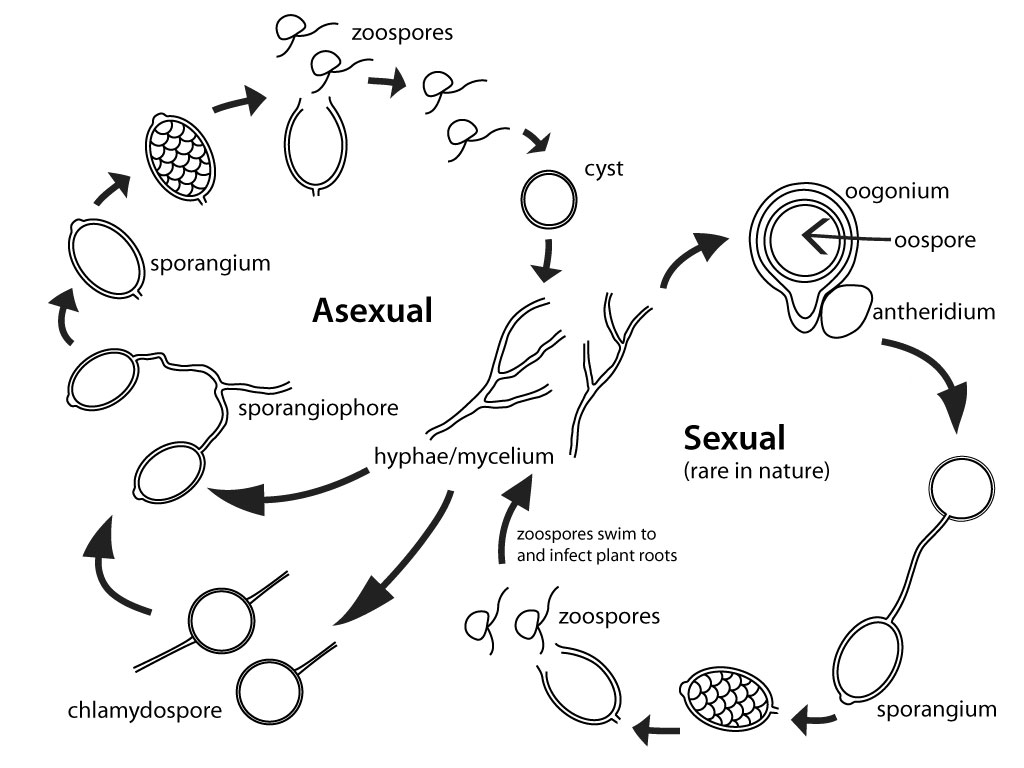About this tool
What is Phytophthora ?
 Phytophthora is a genus of Oomycota (oomycetes or water molds), a phylogenetic group of fungus-like eukaryotes in the phylum Heterokonta, or stramenopiles. Many heterokonts are unicellular flagellates, and some, including Phytophthora, are multicellular with a flagellated single-celled stage in the life cycle called a zoosporezoospore:
Phytophthora is a genus of Oomycota (oomycetes or water molds), a phylogenetic group of fungus-like eukaryotes in the phylum Heterokonta, or stramenopiles. Many heterokonts are unicellular flagellates, and some, including Phytophthora, are multicellular with a flagellated single-celled stage in the life cycle called a zoosporezoospore:
motile spore that forms within the sporangium and exits through the exit pore and is capable of swimming for several hours; it has both a tinsel flagellum and a whip-like flagellum
. The name heterokontheterokont:
pertaining to zoospore fungi with different types of flagella; e.g., in <em>Phytophthora</em> species, the zoospore has both a whiplash flagellum and a tinsel flagellum
refers to the characteristic form of these cells, with differentiated flagellaflagella:
whip-like appendage on the zoospore used in motility; zoospore has a long whiplash flagellum with a smooth surface and a shorter tinsel flagellum on which mastigonemes (hair-like structures) occur
, one whiplash and one tinsel. The whiplash straminipilous flagellumflagellum:
whip-like appendage on the zoospore used in motility; zoospore has a long whiplash flagellum with a smooth surface and a shorter tinsel flagellum on which mastigonemes (hair-like structures) occur
is covered with tripartite (with three regions each) mastigonemes (lateral bristles).
Much like fungi, oomycetes are filamentous, microscopic organisms that reproduce both sexually and asexually and absorb nutrients from their substrate either saprophytically or pathogenically. Oomycetes differ from fungi in that their cell walls are made of cellulose and beta glucans rather than chitin, their hyphaehyphae:
single, tubular filament of a fungal or oomycete thallus; the basic structural unit of a fungus or oomycete
lack cross-walls (septations), and their life cycle is primarily diploid rather than haploid. Oomycetes include some of the most serious plant pathogens; almost all known Phytophthora species can cause disease symptoms in plants.
Phytophthora has become one of the most studied genera of plant pathogens. The genus includes many species reported to cause root, crown, and collar rots, wilts, leaf and stem blights, fruit and tuber rots, cankers, bleeding cankers, and stem dieback, resulting in economic impacts to crops, ornamentals, and forest ecosystems around the world. Some species are particularly devastating plant pathogens that have a significant impact in agriculture or natural ecosystems; among them are P. austrocedri, P. capsici, P. cinnamomi, P. infestans, P. kernoviae, P. quercina, and P. ramorum.
Life cycle
Chlamydospores or oosporesoospores:
zygote or thick-walled spore that forms within the oogonium after fertilization by the antheridium; may be long-lived
germinate in wet conditions to form sporangiasporangia:
sac within which zoospores form, especially when water is cooled to about 10°C below ambient temperature; in solid substrates, sporangia usually germinate by germ tubes
. SporangiaSporangia:
sac within which zoospores form, especially when water is cooled to about 10°C below ambient temperature; in solid substrates, sporangia usually germinate by germ tubes
release tiny, single-celled swimming spores called zoosporeszoospores:
motile spore that forms within the sporangium and exits through the exit pore and is capable of swimming for several hours; it has both a tinsel flagellum and a whip-like flagellum
. ZoosporesZoospores:
motile spore that forms within the sporangium and exits through the exit pore and is capable of swimming for several hours; it has both a tinsel flagellum and a whip-like flagellum
can swim through water on leaf surfaces or through water-logged soil, but they are susceptible to drying. ZoosporesZoospores:
motile spore that forms within the sporangium and exits through the exit pore and is capable of swimming for several hours; it has both a tinsel flagellum and a whip-like flagellum
are attracted to plant roots as they swim through the soil, and when they find one, they form a cyst. Some Phytophthora species may encystencyst:
to form a cyst or protective covering
and infect leaves as well as roots. Cysts germinate to form microscopic thread-like structures called hyphaehyphae:
single, tubular filament of a fungal or oomycete thallus; the basic structural unit of a fungus or oomycete
, and the pathogen grows into the plant tissues to obtain nutrients, infecting the plant. The Phytophthora then produces more chlamydosporeschlamydospores:
an asexual spore with a thickened inner wall that is delimited from the mycelium by a septum; may be terminal or intercalary, and survives for long periods in soil
(asexually) or oosporesoospores:
zygote or thick-walled spore that forms within the oogonium after fertilization by the antheridium; may be long-lived
(sexually), then sporangiasporangia:
sac within which zoospores form, especially when water is cooled to about 10°C below ambient temperature; in solid substrates, sporangia usually germinate by germ tubes
, and the life cycle continues.

Please visit the morphological identification section to learn more about how Phytophthora morphology can be used to identify species within the genus.

